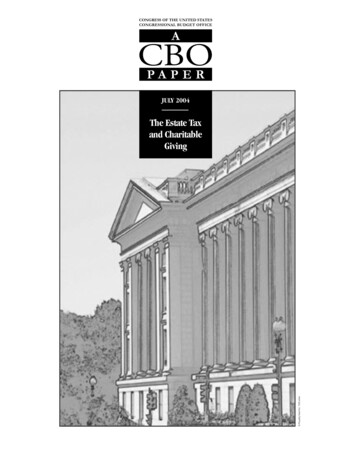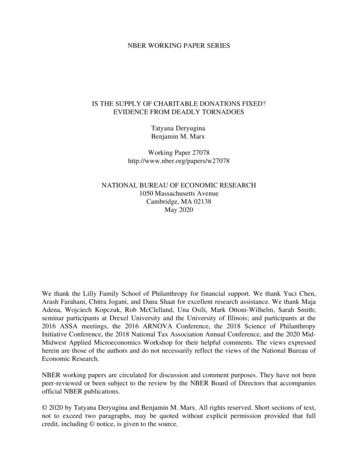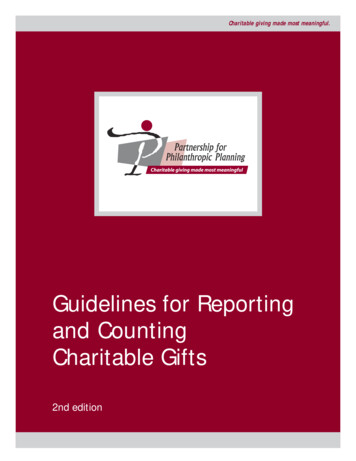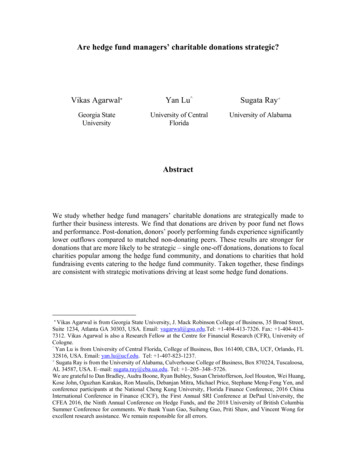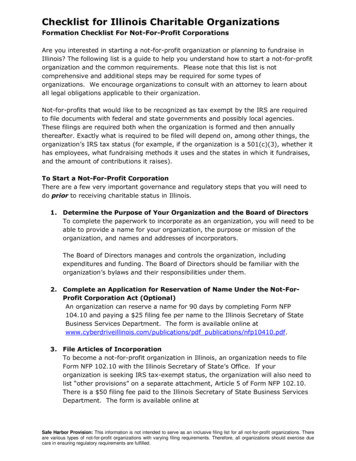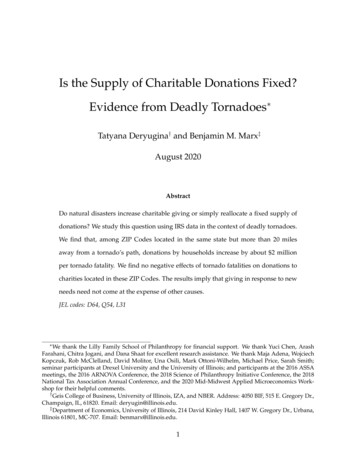
Transcription
Is the Supply of Charitable Donations Fixed?Evidence from Deadly Tornadoes Tatyana Deryugina† and Benjamin M. Marx‡August 2020AbstractDo natural disasters increase charitable giving or simply reallocate a fixed supply ofdonations? We study this question using IRS data in the context of deadly tornadoes.We find that, among ZIP Codes located in the same state but more than 20 milesaway from a tornado’s path, donations by households increase by about 2 millionper tornado fatality. We find no negative effects of tornado fatalities on donations tocharities located in these ZIP Codes. The results imply that giving in response to newneeds need not come at the expense of other causes.JEL codes: D64, Q54, L31 Wethank the Lilly Family School of Philanthropy for financial support. We thank Yuci Chen, ArashFarahani, Chitra Jogani, and Dana Shaat for excellent research assistance. We thank Maja Adena, WojciechKopczuk, Rob McClelland, David Molitor, Una Osili, Mark Ottoni-Wilhelm, Michael Price, Sarah Smith;seminar participants at Drexel University and the University of Illinois; and participants at the 2016 ASSAmeetings, the 2016 ARNOVA Conference, the 2018 Science of Philanthropy Initiative Conference, the 2018National Tax Association Annual Conference, and the 2020 Mid-Midwest Applied Microeconomics Workshop for their helpful comments.† Geis College of Business, University of Illinois, IZA, and NBER. Address: 4050 BIF, 515 E. Gregory Dr.,Champaign, IL, 61820. Email: deryugin@illinois.edu.‡ Department of Economics, University of Illinois, 214 David Kinley Hall, 1407 W. Gregory Dr., Urbana,Illinois 61801, MC-707. Email: benmarx@illinois.edu.1
1IntroductionCharitable donations are an important source of funding for public goods and redistribution. Overall, U.S. charitable giving makes up about 2 percent of GDP (List, 2011). Butit is not well-understood whether an exogenous shock to human need, such as a natural disaster, increases total giving or simply displaces donations that would have gone toother causes. Many laboratory experiments find that incentives or opportunities to donate to one charity reduces giving to the others.1 However, the laboratory setting maynot be reflective of typical giving. Outside of the laboratory, credible causal estimates ofdisplacement effects between causes are rare and generally encompass a small share ofcharities or of total donations.We estimate whether deadly tornadoes increase the total amount of charitable giving.We measure charitable giving using an annual panel of ZIP-Code-level individual incometax data from the Internal Revenue Service (IRS), which report all income tax deductionsclaimed for donations to any registered charity in 2002–2017. Only about 30 percent ofhouseholds itemize deductions, and itemized donations are disproportionately concentrated among high-income households (Internal Revenue Service, 2020). However, about84 percent of donations by individuals are itemized, and giving by individuals comprisedabout 70 percent of all giving in 2017 (Giving USA Foundation, 2018).We combine the IRS data with geospatial information on the incidence of tornadoes.We focus our attention on lethal tornadoes, which allows us to identify events that affected populated areas and caused tens of millions of dollars’ worth of damage, on average. Tornadoes offer a useful natural experiment because they vary over both space andtime but are generally limited in their geographic scope. Because tornadoes are shortlived and unpredictable, scientists have not been able to capture most tornadoes’ physicalproperties, such as wind speed. Instead, the National Oceanic and Atmospheric Admin1 See,for example, Reinstein (2012); Cairns and Slonim (2011); Reinstein (2011); Corazzini, Cotton andValbonesi (2015); Ek (2017); Filiz-Ozbay and Uler (2017); Deck and Murphy (2019); Harwell, Zindler andEckel. (2020); Schmitz (2019).2
istration (NOAA) maintains a database capturing tornado-related fatalities, injuries, andproperty damage—which are functions of both the tornado’s physical properties and thecharacteristics of the area in which it touches down—of each reported tornado since 1950.Our identifying assumption is that, conditional on a host of fixed effects and controls,tornado fatalities are unrelated to any unobservable determinants of charitable giving.We find that lethal tornadoes significantly increase total charitable donations by individuals living nearby but outside of the directly affected area. Specifically, a tornadofatality increases total donations by individuals living at least 20 miles away from a tornado’s path but in the same state by about 2 million. Because total giving increases, wecan rule out perfect substitution between charitable causes and conclude that the supplyof donations is not fixed.We then estimate fatal tornadoes’ effects on the receipts of charities using data frominformation returns that charities file annually with the IRS. The charitable response to asevere tornado typically involves providing victims with basic necessities such as food,clothing, and shelter; tools for clean-up, such as gloves and shovels; and health services,including for mental health.2 This work is done both by large organizations like the American Red Cross and by local organizations. We show that contributions received by charities within 20 miles of a tornado’s path increase by more than 1 million per fatality. Wealso test whether there is a negative displacement effect on charities in locations morethan 20 miles away but in the same state—locations from which total giving increased.Our estimate of the effect on donations to charities in these locations is positive and notstatistically significant, suggesting that donations to these charities do not decrease because of increased giving in response to fatal tornadoes.Charitable giving for natural disasters is common, with a nationally representativesurvey indicating that about 30 percent of U.S. households made such donations in eachof 2017 and 2018 (Bergdoll et al., 2019). Motivations for disaster giving vary, as demon2 cross.org/about-us/our-work/disaster-relief/3
strated by two experimental papers studying giving to victims of Hurricane Katrina.Eckel, Grossman and Milano (2007) find that facts about the aftermath and languageemphasizing a charity’s involvement in the relief effort has a positive effect in a distantlocation (Minnesota) but a negative effect in a location closer to the hurricane (Texas).Fong and Luttmer (2009) find that showing victims of subjects’ own race has a positive ornegative effect on giving depending on whether the subjects report feeling close to theirracial or ethnic group. Factors external to the donor many also influence the post-disastergiving response: Brown and Minty (2008) find a correlation between media coverage andinternet giving for the devastating 2004 Asian tsunami.3 To our knowledge, our paperis the first to quantify the charitable response to natural disasters using administrativedata.4 With these data we observe donations to the full spectrum of causes, allowing usto estimate effects on total giving.Our paper studies whether disaster giving displaces other giving. Nearly 80 percentof U.S. households reported that their disaster giving did not affect their giving to othercauses (Bergdoll et al., 2019), but people may be reluctant to admit that they reducedcharitable giving to other causes. Consistent with the survey evidence and ours, however, Scharf, Smith and Wilhelm (2017) find that donors to international disasters do notdecrease their giving to other causes. Using time-series variation, they study donationsby individuals in the UK in the weeks following each of six appeals for major international disasters occurring between June 2009 and July 2014. By contrast, we are able todefine treatment and control groups in each year and estimate relative changes amongthe treated.The extent to which individuals substitute donations to one charity for donations to3Arelated literature focuses on the determinants of domestic or foreign disaster aid (e.g. Besley andBurgess, 2002; Garrett and Sobel, 2003; Drury, Olson and Van Belle, 2005; Eisensee and Strömberg, 2007;Strömberg, 2007; Healy and Malhotra, 2009; Cole, Healy and Werker, 2012; Deryugina and Kirwan, 2018).4 Our use of individual income tax data follows the literature on the tax-price elasticity of charitablegiving (Randolph, 1995; Auten, Sieg and Clotfelter, 2002; Bakija, Gale and Slemrod, 2003; Bakija and Heim,2011). Our use of the information returns that nonprofit organizations file with the government followsstudies estimating the effects of government grants on charities’ fundraising efforts (Andreoni and Payne,2003, 2011).4
another appears to vary across settings. In theory, increases in the number of charities orin the number of people served by a charity have ambiguously signed effects on donations (Rose-Ackerman, 1982, 1987). The supply of donations may be completely fixed ifgiving exhibits “mental accounting” (Tversky and Kahneman, 1981; Kahneman and Tversky, 1984; Thaler, 1985, 1999). Descriptively, the ratio of charitable donations to incomehas been fairly constant over time (Andreoni and Payne, 2013) and across income categories (Meer and Priday, 2020). Field-study findings differ regarding whether intertemporal displacement does or does not occur (Meier, 2007; Landry et al., 2010; Bekkers,2015)) and whether displacement between causes does or does not occur (Lacetera, Macisand Slonim, 2012; Meer, 2017; Chatterjee et al., 2020; Petrova et al., 2020; Adena andHager, 2020). In a review of this literature, Gee and Meer (2019) conclude that “the evidence is decidedly mixed on whether the altruism budget is fixed or flexible.” Our paperis the first to employ data that contain the majority of dollars donated across the U.S. andthe first to identify effects using a natural experiment with both geographic and temporalvariation.The rest of the paper is organized as follows. In Section 2 we describe our data. InSection 3 we lay out our empirical strategy for estimating the effects of tornado fatalitieson charitable giving. In Section 4 we report our results. We conclude in Section 5.22.1DataCharitable donations to all causesAnnual data on charitable donations come from the IRS (IRS, 1998–2017). The data arebased on individual income tax returns, including all Forms 1040, 1040A, and 1040EZ.They report deductions claimed for charitable donations in 2002 and in 2004–2017. Wealso make use of the number of tax returns that include such deductions, the total numberof returns, and total Adjusted Gross Income (AGI). In real terms, charitable deductions5
over this period ranged from 173 billion in 2009 to 226 billion in 2017 (2017 dollars).Donations were relatively low in 2008–2013, during and after the Great Recession (seeAppendix Figure A.1).Returns are compiled by filing year, providing totals based mostly on the precedingtax year but also including some late returns for the previous tax year. Data are aggregated by the ZIP Code listed on the return, which is usually the ZIP Code of the taxpayer’shome address but could alternatively be the address of a lawyer, accountant, or place ofbusiness. We focus on ZIP Codes located in the contiguous United States.The IRS data provide an unbalanced panel of 37,274 ZIP Codes on which we imposea few additional restrictions. The IRS has taken varying steps to avoid disclosure of information about individual taxpayers. ZIP Codes with fewer than a threshold numberof returns are excluded from the dataset, and charitable donations below an undisclosedthreshold are coded as zeroes. We restrict our sample to ZIP Code-year observations withat least 250 returns (the most stringent threshold). This restriction omits 8,406 small ZIPCodes that comprise about 0.3 percent and 0.2 percent of total observed AGI and charitable giving, respectively. Because IRS disclosure rules prevent us from distinguishingtrue zeroes in the data from censored values, we also restrict the sample to ZIP Codes forwhich charitable contributions are always reported to be strictly positive. This restrictionomits an additional 1,467 ZIP Codes that comprise about 0.2 and 0.03 percent of total AGIand charitable giving, respectively. Finally, we drop 458 ZIP Codes that only appear inthe data once.To match ZIP Codes to their geographic location, we use the U.S. Census Bureau’sZIP Code Tabulation Areas (ZCTAs), which are spatial representations of the mailingareas covered by ZIP Codes (U.S. Census Bureau, 2010).5 To account for changes in thecoverage of ZIP Codes over time, we use data from the U.S. Postal Service (USPS, 2001–5 gov/programs-surveys/geography/guidance/geo-6
2020).6 The most common changes are creations of new ZIP Codes for part of an areapreviously covered by another ZIP Code and elimination of ZIP Codes when a post officeis closed. Each change reports two ZIP Codes, which we combine with each other andwith all other ZIP Codes to which they are connected through one or more changes tocreate a set of time-invariant “super-ZIPs.” We aggregate our data to the super-ZIP levelby summing all IRS variables over the ZIP Codes included in a super-ZIP. Hereafter, wesimply refer to these super-ZIPs as ZIP Codes.Figure 1 maps the 26,940 ZIP Codes in our final sample (red areas). Areas that aredropped because of the aforementioned sample restrictions are in light grey. Not all partsof the U.S. are part of a ZCTA; these areas are displayed in white. Our coverage is sparsestin the Mountain States—especially Utah and Nevada—as well as the Dakotas. Becausethe omitted areas comprise a very small share of charitable giving and experience few orno tornado fatalities during our sample period, our results are unlikely to be affected bytheir exclusion.About 30 percent of households itemized their deductions in the years of our sample(Internal Revenue Service, 2020). Income tax data are therefore likely to underestimate thetotal change in individual donations in response to tornadoes.7 Moreover, itemization isincreasing in income: in 2014, households with AGI below 50,000 made up 29 percent ofitemizers but 69 percent of filers. Our estimates will therefore not capture the charitablegiving response of the average household, but they are more representative of the averagedollar of donations. This is because higher-income households donate more money onaverage, and an estimated 84 percent of donations is itemized (Indiana University LillyFamily School of Philanthropy, 2017; Giving USA Foundation, 2018).6 Eachmonth, the USPS produces a Postal Bulletin that includes a table of changes to ZIP Code deliveryareas.7 Alternatively, we might overestimate the total charitable response by individuals if tornadoes causeindividuals who have given but not claimed deductions to start claiming deductions. Appendix Table A.3shows, however, that the number of returns claiming charitable deductions is not significantly affected bytornado fatalities.7
2.2TornadoesTornadoes are rotating columns of air that form during strong thunderstorms. Winds canreach up to 300 miles per hour, causing catastrophic damage to structures with whichsuch a tornado comes in contact. Our data on tornadoes come from NOAA’s TornadoDatabase, which reports the date and location of every known tornado since 1950, as wellas the amount of property damage, fatalities, and injuries it caused (NOAA, 1950–2017).8Tornadoes are common in the U.S. In 2002–2017, the period spanned by our IRS data,14,533 tornadoes were reported, and every state in the contiguous U.S. experienced atleast one. However, almost half of these tornadoes (6,928) caused no known propertydamage, fatalities, or injuries and are thus highly unlikely to have triggered a responseby a charity. Even among the thousands of tornadoes that involved fatalities, injuries,or property damage, the median number of each of these is zero (see Panel A of Appendix Table A.1). We therefore restrict attention to tornadoes that are most likely to haveprompted a response by charitable organizations: those that caused at least one fatality.Such tornadoes are fairly rare—there were 327 of them during our sample period—andare substantially more devastating than average.9 On average, a fatal tornado kills fourpeople, causes about 35 injures, and destroys over 50 million worth of property (seePanel B of Appendix Table A.1). Using data for tornado-related disasters in the years2004–2017, we calculate that the mean amount of federal disaster aid per tornado fatalitywas 13.3 million and the median was 2.98 million (2008 dollars)10An additional advantage of using fatalities to measure severity is that they are morelikely to be reported accurately than property damage or injuries. For example, NOAA8 Unfortunately,because tornadoes form and dissipate quickly and have wind speeds that are muchhigher than that of a hurricane, scientists have not been able to reliably measure most tornadoes’ windspeed (Di Justo, 2013). Instead, tornadoes are rated using the “Enhanced Fujita” (EF) scale, which is basedon the observed ex post damage (National Oceanic and Atmospheric Administration, 2020).9 For reference, there were 117 landfalling hurricanes and tropical storms in 2002–2017, and only 24 ofthem made landfall with hurricane-strength winds.10 These data were obtained from https://www.fema.gov/disasters. We calculate the average and median amounts of federal disaster aid by dividing the total state-year disaster aid for tornado-related disasters by the corresponding number of fatalities.8
records uncertain damage as zero damage, and there is no way to distinguish unknownvalues from true zeroes. While injuries may also indicate severity, they are also likely to bereported with greater error than fatalities. Furthermore, no distinction is made betweenminor and major injuries, making them less comparable to each other than fatalities.Nonetheless, tornado fatalities, injuries, and damage are highly correlated. Amongfatal tornadoes in 2002–2017, the correlation between fatalities and damage is 0.88 andthe correlation between fatalities and injuries is 0.86.11 Each additional tornado fatality isassociated with 8.2 additional injuries and additional property damage of 18.5 million.Given the high degree of correlation between these variables, we use fatalities as a singleseverity measure, and our estimates should be interpreted as reflecting the charitableresponse to a bundle of tornado characteristics.Figure 1 displays the paths of the 327 tornadoes that formed in 2002–2017 and causedat least one fatality. These tornadoes affected 1,301 ZIP Codes in 34 states. Three keypatterns emerge. First, fatal tornado strikes are concentrated in the Midwest and theSouth, an area known as “Tornado Alley”. Second, deadly tornadoes have struck acrossa wide range of most of the states in which they have occurred. Third, tornadoes are localevents, with even the largest rarely passing through more than a handful of ZIP Codes.We calculate the distance between ZIP Codes and tornadoes using latitude and longitude. These coordinates are available for the start and end points of each tornado. We calculate the latitude and longitude of 2010 ZIP Code centroids using data from Esri (2014).We then calculate the shortest distance between each ZIP Code centroid and the line segment connecting the start and end points of the tornado.Fatalities are reported at the tornado level. Because we do not know the locationsof fatalities along the tornado path, we sum all fatalities caused by tornadoes that passedwithin a distance band of interest from a given ZIP Code centroid.12 This process will cre11 Amongall tornadoes that cause any damage, fatalities, or injuries, the correlation between fatalitiesand damage is 0.84 and the correlation between fatalities and injuries is 0.86.12 If a tornado affects multiple states, we divide fatalities equally among the affected states (usually two).9
ate some degree of mismeasurement, but our design does not depend on finely measureddistances.2.3Contributions received by charitiesIncome tax returns report the total amount of charitable donations made but not the organizations to which the money was given. Thus, the income tax data cannot be used toassess how tornadoes affect giving to particular organizations or causes. To do so, we usedata on contributions received by charities themselves. These data have been collectedby the IRS using Form 990, the annual information return that most charities are requiredto file (Urban Institute, 1998–2016).13 Data are available for the years 1998–2016, but wedrop years prior to 2002 for comparability with the individual income tax data. Our mainvariable of interest is contributions, which is the sum of donations and grants.Data are reported by year and Employer Identification Number (EIN). Because fiscalcycles do not always overlap with calendar years, we match the tornado data to eachcharity’s fiscal cycle by month and then aggregate to the annual level using the year inwhich the fiscal year ends. When EIN-year duplicates appear in the files provided by theIRS, we keep the observation from the earliest data file. To address likely reporting errors,we drop observations with non-positive contributions or expenses. We also address location discrepancies that are likely to be errors. If a charity’s ZIP Code in year t 1 matchesthat in year t 1 but not in year t, we replace the ZIP Code in year t so that it is consistentover time. We then replace the ZIP Code with our time-invariant “super-ZIP”. Finally, wereplace the reported state with the state to which the super-ZIP belongs according to the2010 Esri ZIP Code centroids file.13 Religiouscongregations are not required to file Form 990.10
3Empirical strategy3.1Estimation approachWe estimate how fatal tornadoes affect total charitable giving. Our primary specificationuses the inverse hyperbolic sine (IHS) of fatalities as a proxy for overall severity. We focuson areas that are near tornadoes but not directly affected by them because charitablegiving responses in directly affected areas are more difficult to interpret. For example,tornadoes may have negative income effects in areas where they strike or generate a largein-kind giving response, which we cannot measure with our data. Our identificationassumption is that, conditional on location and time fixed effects, the number of fatalitiescaused by tornadoes is unrelated to other determinants of charitable giving. To that end,we estimate: I HS(dit ) β 1 I HS( f atalities0it 20 ) β 2 I HS( f atalities20it )(1) αi αvt X it ε it ,where the outcome I HS(dit ) is the IHS of charitable donations in ZIP Code i in year t. The key parameter of interest is β 2 , which is the coefficient on the variable I HS( f atalities20it ),the IHS of tornado fatalities that occurred within the same state but more than 20 milesaway from i. We control for any direct impacts with I HS( f atalities0it 20 ), the IHS of fatalities within 20 miles of ZIP Code i. In alternative specifications, we vary the functionalforms and measures of tornado severity. The variables αi control for unit fixed effects.Additionally, we control for year fixed effects interacted with ventiles of AGI (αvt ).14 Standard errors are clustered by state.The timing of tornado strikes is unpredictable (Simon, 2019), making the occurrence ofa tornado plausibly exogenous, conditional on location fixed effects. Whether a tornado14 Weuse AGI in the observed year closest to 2010, the midpoint of our sample, using the later year incases of ties.11
causes fatalities, however, is a function of both the physical features of the tornado (e.g.wind speed, size, and duration of existence) and the characteristics of the area in whichit touches down (e.g. population density, building types). Thus, one potential threatto the validity of our estimates is unobservable changes in area characteristics that arecorrelated with the timing of both tornado fatalities and charitable giving. For example,while our design is not a pre-post difference-in-differences, estimates could still be biasedif severe tornadoes became more common in states that happen to have economies thatwere growing more quickly. To allow for differential trends and to improve the precisionof our estimates, we include time-varying controls X it in equation (1). These include 3digit-ZIP linear time trends and cubic functions of the number of tax returns and totalAGI, both of which we show to be unaffected by tornadoes (Appendix Table A.3).Another concern with equation (1) is that the same-year specification may not capturethe full response of charitable giving to severe tornadoes. Scharf, Smith and Wilhelm(2017) find that natural disasters have short-run time-shifting effects on donations to othercharities but find no net effect over a 20-week period. Appendix Figure A.2 shows thattornado casualties occur throughout the year but are most prevalent in April and May,therefore allowing enough time for the full net effects to be captured in our annual data.We also estimate variants of equation (1) using the Form 990 data from charitableorganizations. In these equations, the unit of observation is an EIN, and the outcomeis contributions received. The time-varying controls are linear trends for the 3-digit ZIPCode in which a charity is first observed.3.2Summary statisticsTable 1 summarizes the IRS income tax data for ZIP Codes that do and do not experiencea nearby fatal tornado during our sample period, either within 20 miles of their centroid(columns (1) and (2)) or within the same state but more than 20 miles away (columns (3)and (4)). Panel A displays averages and standard deviations of baseline (2002) AGI, char12
itable deductions per return, the total number of returns, and the share of returns thathave any contributions reported. Panel B shows 2002–2017 trends in both the levels andthe IHS of these variables.15Of the 26,943 ZIP Codes in our sample, 4,882 have a fatal tornado pass within 20 milesof their centroids, and 22,061 do not. These two sets of ZIP Codes are very similar toeach other (columns (1) and (2)), with no statistically significant differences in the fourvariables of interest at baseline. Trends in these variables are also very similar, exceptfor the IHS of total contributions, which is growing in affected ZIP Codes but falling inunaffected ZIP Codes.Columns (3) and (4) show summary statistics for ZIP Codes that do and do not, respectively, have an in-state fatal tornado more than 20 miles away at some point in the sample.Because fatal tornadoes affect many states during our sample period, the former groupis correspondingly larger: 20,288 ZIP Codes have an in-state fatal tornado more than 20miles away at some point. These ZIP Codes have significantly lower average AGI (about 40,000 versus 52,000), a lower number of returns (4,200 versus 6,000), and a smallershare of returns with charitable contributions (24 percent versus 33 percent). However,the average contribution amounts are similar ( 4,800 versus 4,900). Trends also differsignificantly for a few variables, with ZIP Codes in states with deadly tornadoes exhibiting relatively slow growth in AGI and in the IHS number of tax returns filed but relativelyrapid growth in the average donations per return, suggesting that the relative growth inreturns in these states is among those with less income and donations.These differences in levels and trends highlight the usefulness of the control variablesin equation (1). We also note that our identification comes from locations’ changes inoutcomes in years with deadly tornadoes relative to years without them. Our controlsare therefore not only the areas that experience no fatal tornadoes but also treated areasin years in which there are no in-state tornado fatalities.15 Whethera return claims any charitable deductions was not reported in 2008. Analogous summarystatistics for Form 990 data are available in Appendix Table A.2.13
4Results4.1Donations made to all causesTable 2 shows that fatal tornadoes significantly increase donations to all causes in ZIPCodes located in the same state but more than 20 miles away. The first column showsthe IHS-fatalities specification in equation (1), in which coefficients can be interpreted asapproximate elasticities.16 Thus, a one percent increase in same-state fatalities more than20 miles away increases donations by about 0.0028 percent. Such small elasticities arereasonable because our estimates reflect changes in giving to all types of organizations,most of which do not serve tornado victims.To convert this elasticity into additional dollars donated per tornado fatality, we predict the change in contributions if each of the fatal tornadoes in the sample had causedone additional fatality. This approach accounts for the fact that deadly tornadoes are notevenly distributed across the country and that ZIP Code exposure may be correlated withits annual charitable donations. We average the effects of these counterfactual tornadoesand find that each fatality increases donations by 2.21 million dollars, with a standarderror of 1.09 million (calculated by the delta method).The remainder of Table 2 shows results using alternative functional forms and severity measures. Column (2) employs indicator variables for fatal tornadoes rather than theIHS function and obtains positive estimates that are slightly less precise. Column (3)adds the number of tornado fatalities to this specification. These estimates suggest alarge positive effect of the first fatality and a smaller positive effect of additional fatalities, consistent with the IHS form in column (1). The remaining columns
Charitable donations are an important source of funding for public goods and redistribu-tion. Overall, U.S. charitable giving makes up about 2 percent of GDP (List, 2011). But it is not well-understood whether an exogenous shock to human need, such as a natu-ral disaster, increases total giving or simply displaces donations that would have gone to


